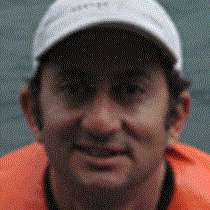Floreana Island
As we get up in the morning, we find ourselves on a completely different setting: Floreana. It’s official name being Santa Maria, it’s the only island named by the Spaniards before it was named Charles by British buccaneers. It was called “de la Aguada,” meaning Holy Mary of Water. This is the oldest inhabited island, the only one with surface fresh water, when Ecuador took possession of the islands in 1832. Animals and plants were introduced after centuries of human exploitation from whalers first, by settlers later. When Galapagos tortoises disappeared, “other” livestock was brought in like cattle, goats and pigs; as well as rats, cats and dogs. Also invasive plants were brought in such as lantana and guava, amongst others. Nowadays, Floreana holds a small population of about 130 people.
We landed at Punta Cormorant before breakfast. We got ashore by having a wet landing on a green beach, composed of small crystals of olivine eroded from the basaltic lavas that have formed the islands. Crabs, shore birds and Galapagos sea lions were the welcoming committee; a gravel trail, lined up by deciduous Palo Santo trees and a mixture of endemic and native plants was our path. A large hyper saline lagoon we walked along had a few, distant, flamingos, and a fishing great blue heron reaching for a morsel or two. At the end of the trail we arrived at the beautiful, white flour beach, nesting site of sea turtles. We were lucky to witness, from a few feet away, a female battling two very willing males… the breeding season has started. The female then crawled out to rest and avoid the searching males.
After breakfast, the ship navigated to Champion Islet, a small off shore cone. This is the only island where a small population of the Floreana mockingbird still exists, the sad impact of the human introductions on the islands. We then went on a Zodiac ride, to look for this rare species. When we were getting back from our successful journey, we had a lengthy encounter with a feeding pod of Bryde baleen whales. The ocean was full of activity – Galapagos shearwaters and Nodi terns, Manta rays and Mobula rays were leaping out of the water. We had to leave, Champion was waiting for us. While snorkeling and riding on the glass bottom boat we saw this exposed reef, the life brought by the current and the wealth of the site. Shark sightings were favorite experiences amongst our guests.
During lunch, the National Geographic Endeavour relocated to Post Office Bay, to visit this renowned bay, where the oldest mail swap tradition was established in 1793 by a British whaler, Capt. James Colnett. We started the activity with a kayaking trip…. we paddled around the rocky outcrops and mangrove shores of the sea lion colony, here these animals bask in the sun accompanied by blue footed boobies and red marine iguanas. Then we all landed to visit the barrel where the mail was, going through postcards and letters left by previous visitors. Trying to find a volunteer to hand deliver some of the mail, and of course to drop off our own, always with the hope that some other visitors will do the same for us!
Our day ended while we explored the bay neighboring sea lion colony by Zodiac. The sun blessed us with vibrant colors with a short appearance. Right after sunset, we took off to our next destination, another day in paradise. We’ll sleep well and happy tonight.




